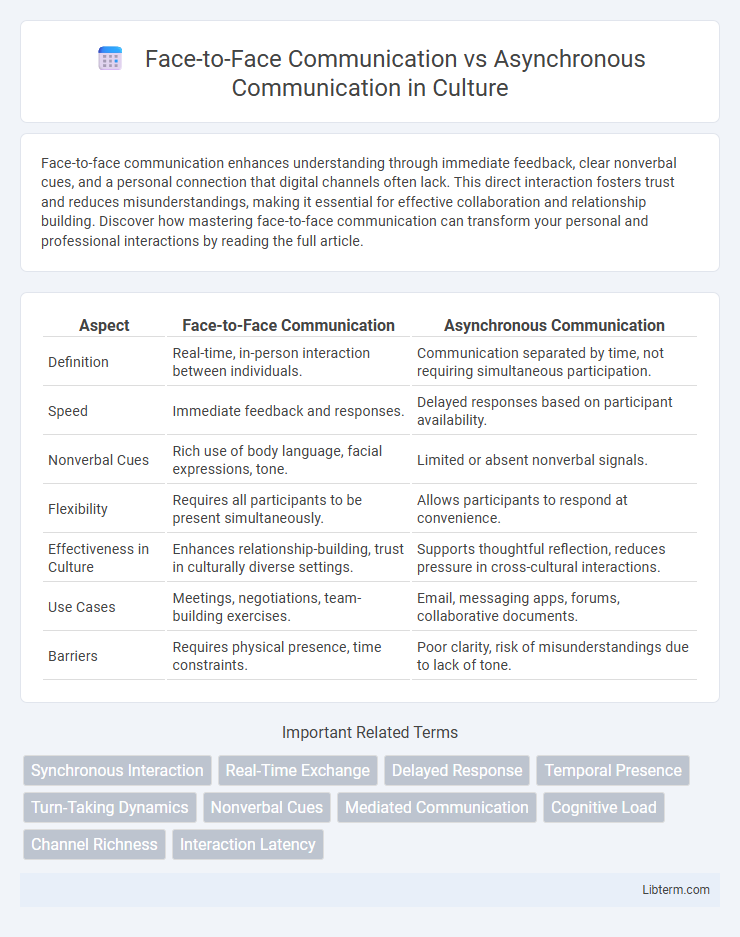Face-to-face communication enhances understanding through immediate feedback, clear nonverbal cues, and a personal connection that digital channels often lack. This direct interaction fosters trust and reduces misunderstandings, making it essential for effective collaboration and relationship building. Discover how mastering face-to-face communication can transform your personal and professional interactions by reading the full article.
Table of Comparison
| Aspect | Face-to-Face Communication | Asynchronous Communication |
|---|---|---|
| Definition | Real-time, in-person interaction between individuals. | Communication separated by time, not requiring simultaneous participation. |
| Speed | Immediate feedback and responses. | Delayed responses based on participant availability. |
| Nonverbal Cues | Rich use of body language, facial expressions, tone. | Limited or absent nonverbal signals. |
| Flexibility | Requires all participants to be present simultaneously. | Allows participants to respond at convenience. |
| Effectiveness in Culture | Enhances relationship-building, trust in culturally diverse settings. | Supports thoughtful reflection, reduces pressure in cross-cultural interactions. |
| Use Cases | Meetings, negotiations, team-building exercises. | Email, messaging apps, forums, collaborative documents. |
| Barriers | Requires physical presence, time constraints. | Poor clarity, risk of misunderstandings due to lack of tone. |
Understanding Face-to-Face Communication
Face-to-face communication enhances understanding through immediate feedback, non-verbal cues, and vocal tone, which convey emotions and clarify intentions. This synchronous interaction reduces misunderstandings and fosters stronger interpersonal connections by allowing real-time adjustments in dialogue. In contrast, asynchronous communication lacks these dynamic cues, potentially leading to delayed responses and misinterpretations.
What Is Asynchronous Communication?
Asynchronous communication refers to the exchange of information where participants respond at different times, such as through email, messaging apps, or recorded videos. This method allows flexibility, enabling individuals to process and reply without the constraints of real-time interaction. Common examples include project management tools like Slack, where team members collaborate efficiently across different time zones.
Key Differences Between Synchronous and Asynchronous Communication
Synchronous communication occurs in real-time, requiring participants to be present simultaneously, which enhances immediate feedback and dynamic interaction, as seen in face-to-face meetings or live video calls. Asynchronous communication allows exchanges to happen over time, enabling flexibility and thoughtful responses without the need for simultaneous presence, typical in emails or message boards. These fundamental differences impact collaboration efficiency, response time, and communication clarity in various professional and social environments.
Advantages of Face-to-Face Communication
Face-to-face communication offers immediate feedback and nonverbal cues, enhancing understanding and emotional connection. It facilitates spontaneous interaction, which can lead to quicker decision-making and problem-solving. This direct form of communication reduces the risk of misunderstandings often found in asynchronous methods such as email or messaging.
Benefits of Asynchronous Communication
Asynchronous communication offers the benefit of flexibility, allowing participants to respond at their convenience, which enhances productivity across different time zones. It supports thoughtful, well-crafted responses by giving individuals ample time to process information and formulate ideas. This mode of communication reduces the pressure of immediate replies, minimizing interruptions and enabling better focus on complex tasks.
Challenges of In-Person Interactions
In-person interactions often face challenges such as scheduling conflicts, limited availability, and geographic constraints, which can hinder timely communication. Nonverbal cues like body language and facial expressions may be misinterpreted, leading to misunderstandings. Environmental factors such as noise and physical distractions also impact the effectiveness of face-to-face communication.
Limitations of Delayed Communication Methods
Delayed communication methods, such as email and messaging apps, often hinder real-time feedback, causing misunderstandings and slower decision-making processes. The lack of immediate interaction can reduce emotional nuance, leading to misinterpretations in tone and intent. This time gap also affects collaboration efficiency, particularly in fast-paced environments where prompt responses are critical.
Impact on Team Collaboration and Productivity
Face-to-face communication fosters immediate feedback and richer emotional cues, enhancing trust and collaboration within teams, which drives higher productivity in complex or creative tasks. Asynchronous communication, such as emails and messaging platforms, offers flexibility and time for thoughtful responses, benefiting teams working across different time zones or requiring detailed documentation. Balancing both methods optimizes team collaboration by leveraging real-time interaction for urgent discussions and asynchronous tools for deep work and inclusivity.
Choosing the Right Communication Channel
Choosing the right communication channel depends on the context, urgency, and complexity of the message. Face-to-face communication excels in conveying tone, emotions, and immediate feedback, making it ideal for sensitive discussions or brainstorming sessions. Asynchronous communication, such as emails or messaging apps, provides flexibility, allowing participants to respond at their convenience, which is beneficial for coordinating across different time zones or handling non-urgent topics.
Future Trends in Workplace Communication
Face-to-face communication remains crucial for building trust and fostering collaboration, but asynchronous communication is rapidly gaining traction due to its flexibility and efficiency in remote work environments. Emerging trends indicate that workplaces will increasingly integrate advanced tools like AI-driven transcription and real-time language translation to enhance cross-timezone collaboration. Hybrid communication models combining synchronous and asynchronous methods are expected to become the standard, optimizing productivity while accommodating diverse employee preferences.
Face-to-Face Communication Infographic

 libterm.com
libterm.com